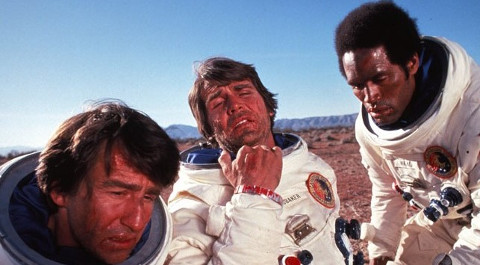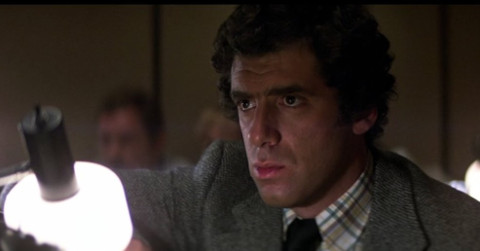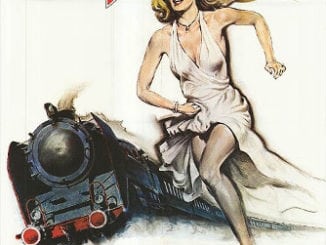Capricorn One (1978)
Directed by: Peter Hyams
Written by: Peter Hyams
Starring: Brenda Vaccaro, Elliott Gould, James Brolin, Sam Waterston
USA
AVAILABLE ON BLU-RAY AND DVD
RUNNING TIME: 123 mins
REVIEWED BY: Dr Lenera
Charles Brubaker, Peter Wallis and John Walker comprise NASA’s first manned mission to Mars. However, seconds before the launch, the three are pulled from the capsule and the rocket leaves earth unmanned, while NASA official James Kelloway tells them that a faulty life-support system would have killed them in-flight and that NASA can’t afford the publicity of a scratched mission. The plan is to fake the Mars landing and keep the astronauts at a remote base until the mission is over, and the astronauts are forced to cooperate with threat of their families’ lives held over them.. However, technician Elliot Whitter sees that something is up and alerts a TV journalist friend, Robert Caulfield. Then Whitter vanishes….
Did we really go to the Moon? The question was on the minds of many when Neil Armstrong took that giant leap for mankind, and then flared up again during the release of this 1978 movie which you can tell was inspired by this issue even if you haven’t read writer/director Peter Hyams’s words on the subject such as, “There was one event of really enormous importance that had almost no witnesses. And the only verification we have came from a TV camera.”. Conspiracy theorists claimed that it was all staged and pointed out things like; inconsistency of shadows suggesting that artificial lights were used, no stars being seen in space, and the flag placed on the surface fluttering despite there being no wind on the Moon. These ideas were either debunked or had their inconsistencies explained by experts, and eventually photographic evidence of human visitation came back from probes exploring the Moon’s surface much later, though some of course still persevered with their theories, and still do. Whatever your viewpoint on the issue, it’s a particularly interesting conspiracy theory for those such as Yours Truly who are also fascinated by space and space exploration. So, what with certain extreme ideas circulating right now regarding Covid-19, and the way that the authorities seem to be intent on suppressing such ideas, I decided to check out this fairly late entry in the cycle of paranoid thrillers made throughout the ’70s, films that exist in a world of intense fear and political corruption, a world in which we should most definitely Not believe what we’re being told. I hadn’t seen Capricorn One in over three decades, and I don’t know why, because it’s surprisingly successful in combining the political conspiracy angle of the likes of The Parallax View and The Conversation with a conventional action thriller, and does it fairly well, even if the ‘journalist’ side is sometimes better done than the ‘astronaut’ side of things, and a few plot details don’t hold water.
Director Peter Hyams [2010, Timecop, End Of Days] is who I would call a journeyman director – but a good one. He wrote the script for this in 1972 but nobody was interested until the Watergate Scandal happened in 1974. TV mogul Lew Grade’s ITC Entertainment had just began branching into film-making, and Grade agreed to finance it after just five minutes. To stay within the budget, NASA’s co-operation was badly needed. Luckily producer Paul N. Lazarus III had a good relationship with the space agency, so the filmmakers were able to obtain government equipment as props despite the negative portrayal of it, including a prototype Apollo Lunar Module. Candice Bergen was asked to play Judy Drinkwater, but turned it down so was replaced by Karen Black. Filming took place at Cinema Center Films in Studio City and in Red Rock Canyon. Hyams later joked, “O.J. Simpson was in it, and Robert Blake was in [Hyams’ first feature] Busting. I’ve said many times: Some people have AFI Lifetime Achievement awards, some people have multiple Oscars, my bit of trivia is that I’ve made films with two leading men who were subsequently tried for the first degree murder of their wives.” The original print had Charles Brubaker opens the emergency rations kit which contains packs of cigarettes, and offer some to the other two; this was cut from subsequent prints because it ‘suggested’ that the government condoned smoking. It was scheduled to debut in the United States in February, but good preview screenings and delays in Superman caused it to move to June. It became the year’s most-successful independent film. Two authors wrote novelizations; Ron Goulart’s version was published in the U.S. and Bernard Ross’s [aka Ken Follett] was published in the U.K, the latter expanding the Robert Caulfield character. Footage from the two main action scenes turned up in several TV series including The A-Team and The Fall Guy.
We’re instantly thrown into the immediate build-up to the first manned mission to Mars, and it all seems pretty authentic and researched, such as the very bizarre meal that the astronauts have to eat! In the crowd watching the take-off are Congressman Hollis Whitter – who’s in charge of the space programme – and the Vice President, who have an uneasy exchange because Whitter wants more support from the President but the latter has more pressing concerns on earth, simply telling the Vice President to, “make it look good”. We’re never told exactly whether the President is involved or not in the subsequent fakery, but immediately authority figures are not presented in a good light with Whitter’s arrogant words to an attendant giving out “special commemorative binoculars” to the attending elite. Whitter deviously talks the guy into giving an extra pair to his wife, signalling very subtly that something will happen if he doesn’t, then tells him that he’ll go far. The message is already clear; go along with what you’re being told to do, or else. Our three astronauts are just about to blast off until somebody comes in and tells them to leave. They’re taken to a room where NASA official James Kelloway butters them up with flattery before showing them the studio where the have to enact their masquerade. Hal Halbrook is simply brilliant in these scenes; he talks and talks but you’re never bored because of the way his character is so two-faced, threatening in a very subtle way [the way he informs Charles Brubaker that his family will die in a plane crash is horrid because he says it like it’s nothing], yet in his own way really passionate about space. He sincerely believes that faking this mission is worth it so that exploration of the cosmos can continue without its image damaged, even if all this is also because the companies that will fund NASA will lose loads of money. It’s a shame that this really quite complex character is thereafter reduced to a straight forward villain.
The faking of the Mars landing is neatly done, with us seeing it the way most others are, on TV, and it looking convincing until we cut to a closer view and then slowly zoom back to reveal the artifice. Things go okay, but Brubaker is increasingly uncomfortable with being held captive to fool the public, and, during a communication with his wife Kay, seems to give her some signal that Kay fails to pick up on. Meanwhile technician Elliot Whitter notices that ground control receives the crew’s televised transmissions before the spacecraft telemetry arrives. He tells his journalist friend Robert Caulfield about this, but has disappeared when Caulfield returns to the pool table they were at after answering a phone call. He then finds somebody else living in Whitter’s apartment who has never heard of him while the place is completely different [how I love this cliche whenever it turns up!], after which he survives a near-death attempt. Upon returning to Earth, the empty spacecraft burns up during atmospheric reentry due to a faulty heat shield. The captive astronauts were supposed to be placed in the returned capsule before being recovered by the Navy, but now realise that they’ll never be released. The alternating of the two strands of the story is at its most extreme here, with the escape of the astronauts inter-cut with Kelloway talking crap before many people. After a while Brubaker, Wallis and Walker really do look starving, exhausted and sun burnt, while black helicopters have never looked so menacing. The increasing action aspect probably put off many critics in 1978, but Hyams did intend to make a popcorn picture. The climactic plane/helicopter chase seems all the more thrilling today because it’s all being done for real. The real-life pilot of the plane Frank Tallman said that this was the most dangerous flying he’d ever done. The fun here is increased by a typically hammy cameo by Telly Savalas [who replaced another screen Blofeld, Donald Pleasance, in the role].
There’s nothing really complex going on, and the slightly dark atmosphere of some of the first half virtually vanishes. This is safe, easily assimilated conspiracy for the family; little cynicism, holding back on the negativity, some thrills from the likes of snakes and tampering with cars but no violence – we don’t even see any of the killings which take place. Hyams goes for simple, even hackneyed devices that still manage to involve, like shadows falling across Caulfield’s face as the truth hits him, and easy emotion, like Kay reading a children’s poem to one of her and Brubaker’s kids and struggling to fight away the tears. Most of the time, it works fine. though the ending does leave us with a few loose ends. Hyams obviously wanted things to end on a reasonably triumphant freeze frame, but the end credits just seem to come up far to quickly, and it’s slightly unsatisfying, though certainly not enough to ruin matters. There’s the finding of a ridiculously convenient piece of evidence; you’d think that, these bad guys being NASA and government officials who can fool the whole nation and arrange virtually anything anywhere, they wouldn’t be so careless as to leave incriminating things behind. And there’s one major hole in the story; surely it would have been far easier if NASA had simply exposed the faulty contractor in the first place? None of the three astronauts really register as characters either. Josh Brolin is his usual charismatic but rather empty-seeming self, while O. J. Simpson is just dreadful except for one scene where he only really acted because Hymans got him to wear painful makeup.
Elliott Gould though does very well, playing an unusually non-quirky person for a change. The archetypal journalist with “an imagination that’s much too vivid” is given subtle little layers, plus the best of the dialogue scenes, be it visiting Kay for information and really wanting to tell her of his suspicions but holding back for fear of upsetting her further, chatting to his long suffering boss Walter Loughlin [it’s especially funny for lovers of The Long Goodbye seeing somebody other than Gould talk in movie quotes], or engaging in sexy banter with colleague Judy Drinkwater, played by Karen Black in another virtual cameo. And then there’s the music score by Jerry Goldsmith which really helps to drive the film forward but is one of his simpler of the period; while there’s a pretty theme for Kay and the odd unrelated set piece, it’s mostly based a really menacing title piece, a jagged ostinato subjected to much development and many variations, Some cues greatly prefigure parts of his Total Recall score. Curiously the original soundtrack album was a re-recording that re-arranged the score for a much larger orchestra and removed a synthesiser. Saying that though, what’s more curious is that, despite being a real crowd pleaser in 1978 [preview audiences clapped], Capricorn One doesn’t seem to be talked of much these days, even if it must have a following seeing as it’s had two Blu-ray releases in the UK. Yet, setting aside the obvious matter of technology, it doesn’t seem particularly dated. I think it’s a film that would be enjoyed by many modern viewers.
Rating: 

















Be the first to comment